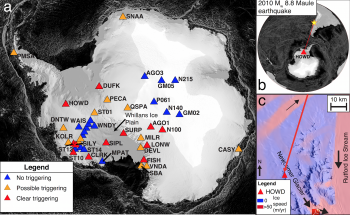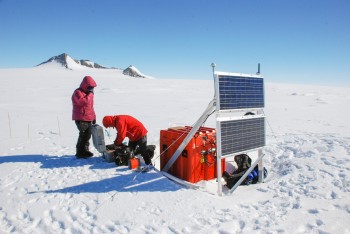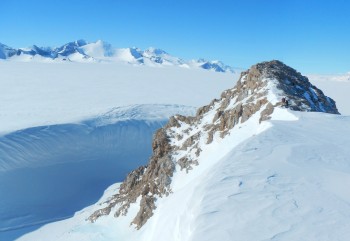2010 Chilean earthquake causes icequakes in Antarctica: Technology allows scientists to hear seismic waves as they arrived on frozen continent
August 13, 2014

Seismic events aren’t rare occurrences on Antarctica, where sections of the frozen desert can experience hundreds of micro-earthquakes an hour due to ice deformation. Some scientists call them icequakes. But in March of 2010, the ice sheets in Antarctica vibrated a bit more than usual because of something more than 3,000 miles away: the 8.8-magnitude Chilean earthquake.
A new Georgia Institute of Technology study, featuring work by a researcher now at the University of Texas at Austin, is the first to indicate that Antarctica’s frozen ground is sensitive to seismic waves from distant earthquakes. The study is published in Nature Geoscience.
“This is one of those findings where you realize the earth works in interesting ways,” said Jake Walter, who is now a research scientist at the University of Texas at Austin’s Institute for Geophysics. “People have noticed this in an anecdotal sense, but we’re the first to document the phenomena.”
To study the quake’s impact on Antarctica, the team looked at seismic data from 42 stations in the six hours before and after the 3:34 a.m. event. The researchers used the same technology that allowed them to “hear” the seismic response at large distances for the devastating 2011 magnitude 9 Japan earthquake as it rumbled through the earth. In other words, they simply removed the longer-period signals as the seismic waves spread from the distant epicenter to identify high-frequency signals from nearby sources. Nearly 30 percent (12 of the 42 stations) showed clear evidence of high-frequency seismic signals as the surface-wave arrived on Antarctica.

“We interpret these events as small icequakes, most of which were triggered during or immediately after the passing of long-period Rayleigh waves generated from the Chilean mainshock,” said Zhigang Peng, an associate professor in the Georgia Tech School of Earth and Atmospheric Sciences who led the study. “This is somewhat different from the micro-earthquakes and tremor caused by both Love and Rayleigh-type surface waves that traditionally occur in other tectonically active regions thousands of miles from large earthquakes.”
Peng says the subtle difference is that micro-earthquakes respond to both shearing and volumetric deformation from distant events. The newly found icequakes respond only to volumetric deformation.
Some of the icequakes were quick bursts and over in less than one second. Others were long duration, tremor-like signals up to 10 seconds. They occurred in various parts of the continent, including seismic stations along the coast and near the South Pole.
The researchers found the clearest indication of induced high-frequency signals at station HOWD near the northwest corner of the Ellsworth Mountains. Short bursts occurred when the P wave hit the station, then continued again when the Rayleigh wave arrived. The triggered icequakes had very similar high waveform patterns, which indicates repeated failure at a single location, possibly by the opening of cracks.
Peng says the source locations of the icequakes are difficult to determine because there isn’t an extensive seismic network coverage in Antarctica.

“But at least some of the icequakes themselves create surface waves, so they are probably formed very close to the ice surface,” he added. “While we cannot be certain, we suspect they simply reflect fracturing of ice in the near surface due to alternating volumetric compressions and expansions as the Rayleigh waves passed through Antarctica’s frozen ice.”
Antarctica was originally not on the research team’s target list. While examining seismic stations in the Southern Hemisphere, Peng “accidently” found the triggered icequakes at a few openly available stations. He and Walter, who was a Georgia Tech postdoctoral student at the time, then reached out to other seismologists (the paper’s four co-authors) who were in charge of deploying more broadband seismometers in Antarctica.
This project is partially supported by a National Science Foundation CAREER grant (EAR-0956051). Any conclusions expressed are those of the principal investigator and may not necessarily represent the official views of the NSF.
Listen to the Icequakes
http://shadow.eas.gatech.edu/~zpeng/Movie/M1_Chile_02272010_HOWD.mov
http://shadow.eas.gatech.edu/~zpeng/Movie/M2_Chile_02272010_AGO1.mov
http://shadow.eas.gatech.edu/~zpeng/Movie/M3_Chile_02272010_N100.mov
http://shadow.eas.gatech.edu/~zpeng/Movie/M4_Chile_02272010_LONW.mov
http://shadow.eas.gatech.edu/~zpeng/Movie/M5_Chile_02272010_SILY.mov
High-frequency icequakes at seismic stations in Antarctica caused by the distant waves of the 2010 magnitude 8.8 Chile earthquake. The triggered icequakes are indicated by the narrow vertical bands in the middle and lower sections of the graphic. They begin when the P wave arrives approximately 8 minutes (480 seconds) after the Chilean quake and continue through the arrival of the Rayleigh waves. The sound is generated by speeding up the stations’ seismic data 100 times.
